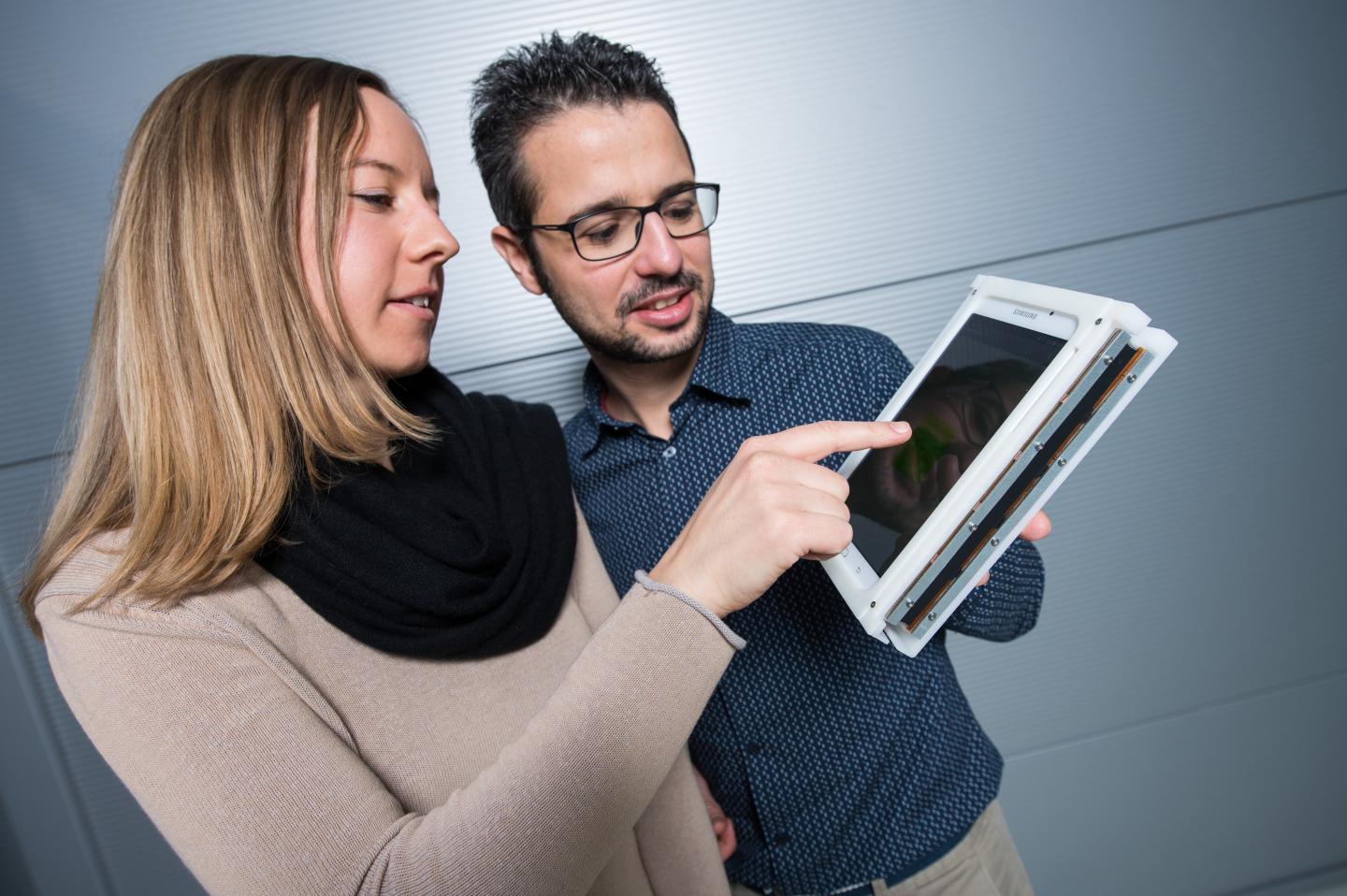Hannover Messe

Credit: Credit: Oliver Dietze
By pulsing or vibrating on demand, smartphone screens can help users navigate through a menu or can guide a user’s finger to virtual on-screen buttons that can be created or removed wherever and whenever needed. Professor Stefan Seelecke and his team at Saarland University have developed a film that gives touchscreens a third dimension. The thin and extremely lightweight silicone film can adopt a variety of positions and shapes and can be made to execute a single pulse, a pushing motion, a sudden jolt or a prolonged vibration at a specific location on the screen. The polymer film also exhibits sensor properties and can therefore provide the device with an added sense organ.
The team of Saarbrücken engineers will be exhibiting their technology at this year’s Hannover Messe from the 1st to the 5th of April at the Saarland Research and Innovation Stand (Hall 2, Stand B46).
While moving a fingertip over the smartphone screen, the user suddenly feels a pulsing sensation under their finger and a button magically appears at that point on the screen. Or the user follows a tactile signal that guides their finger across the screen to where the button is located. New technology that has been developed by Professor Stefan Seelecke and his research team at the Intelligent Material Systems Lab at Saarland University and at ZeMA (Center for Mechatronics and Automation Technology) in Saarbrücken allows buttons to appear and disappear at any point on the touchscreen of an IT device. By generating vibrations, pulses or individual jolts that are felt by the user’s fingertip, the screen can guide the user’s finger to a virtual button at any required location on the display. This new functionality opens up a whole range of options for computer games, for internet searches and for satnav devices.
The basis for this new generation of displays is a rather unremarkable looking sheet of silicone film – not a lot unlike a piece of household cling film. ‘The material the film is made from is known as a dielectric elastomer,’ explains Professor Stefan Seelecke, whose group has received numerous accolades at international conferences for their work on these films.
The engineers in Seelecke’s team print an electrically conducting layer onto an extremely thin polymer membrane. This allows them to apply an electric voltage to the film. Because the film is ‘electroactive’, it contracts in one direction and expands in the other when a voltage is applied to it. ‘As a result of electrostatic attractive forces, the polymer film can, for example, be squeezed vertically, causing it to expand outwards,’ explains Steffen Hau, a PhD engineer working in Seelecke’s team. If the researchers alter the electric field, the film responds by performing complex choreographies and produces tactile signals that range from high-frequency oscillations to pulsing motions like a heart beat or continuous variable flexing motions. The prototype system that the research team is showcasing at Hannover Messe combines their novel electroactive film with a smartphone’s touchscreen. This not only enables virtual buttons to be created on the phone’s screen, it opens up a whole range of additional screen functions.
Using intelligent algorithms, the Saarbrücken team can transform a piece of polymer into a technical component whose behaviour can be precisely controlled. ‘We use the film itself as a position sensor and this imparts sensory properties to the display. There’s no need for any other sensors,’ says Steffen Hau. The research team can precisely assign any change in the position of the film to a change in the film’s capacitance. ‘This means that we always know exactly how the film is deforming at any specific moment. By measuring the capacitance of the dielectric elastomer, we can infer the exact amount of mechanical deformation in the film. By changing the applied voltage, we can precisely control the shape of the film,’ explains Dr. Hau. Any required sequence of motion can be calculated and programmed in the control unit.
‘As this technology does not rely on rare earths or copper, it can be manufactured cheaply, it consumes very little energy and the polymer films are astonishingly light,’ adds Professor Seelecke. The work being done in the Seelecke group on these deformable electroactive polymers is applications-focused research. While at Hannover Messe, the Saarbrücken engineers will be looking for commercial and industrial partners with whom they can develop their system into marketable products.
###
Press photographs are available at http://www.
and may be used free of charge.
This press release is available in German at:
https:/
Contact for press enquiries:
Prof. Dr. Stefan Seelecke, Department of Intelligent Material Systems at Saarland University: Tel. +49 (0)681 302-71341, Email: [email protected]
Steffen Hau, Tel.: +49 (0)681 302-71354, Email: [email protected]
Paul Motzki, Tel.: +49 681 85787-545; Email: [email protected]
Background:
ZeMA – Center for Mechatronics and Automation Technology in Saarbrücken – is a research hub for collaborative projects involving researchers from Saarland University, Saarland University of Applied Sciences (htw saar) and industrial partners. ZeMA is home to a large number of industry-specific development projects that aim to transform research findings into practical industrial applications.
http://www.
Media Contact
Dr. Stefan Seelecke
[email protected]
Original Source
https:/



